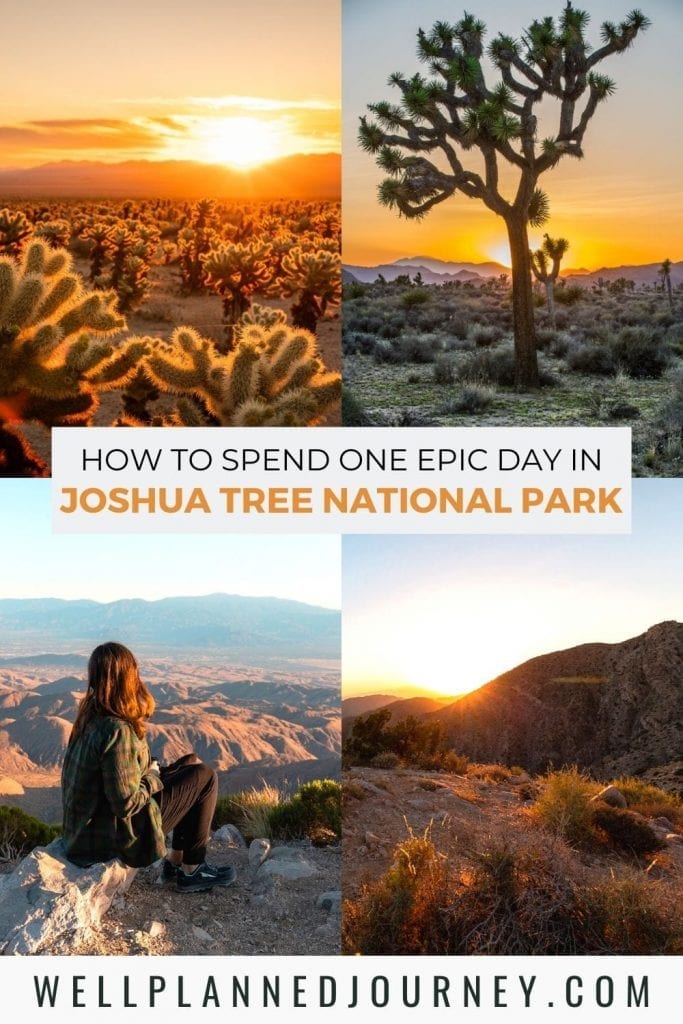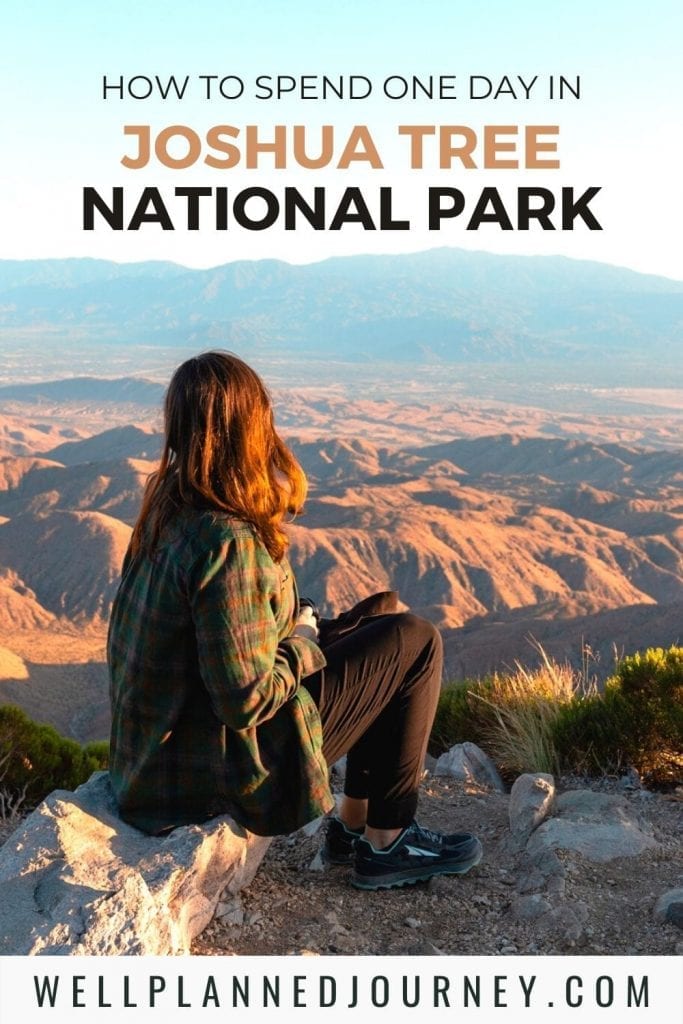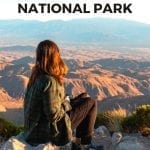Joshua Tree National Park is a desert oasis, rock climbing paradise, and a truly unique landscape. This national park attracts everyone, from photographers to adventure enthusiasts.
One day in Joshua Tree National Park is the perfect way to explore California’s desert landscape.
Joshua Tree National Park has so much to offer. The park is easy to navigate, allowing you to see the major highlights in one day. The park’s simple layout makes it the perfect weekend trip from major cities like Los Angeles or Las Vegas.
This one day in Joshua Tree National Park itinerary covers everything you need to know for your trip, including:
- Important trip planning details like how to get there, when to visit, and where to stay
- The best things to do on your day trip to Joshua Tree
- Frequently asked questions about your Joshua Tree itinerary
This post may contain affiliate links, where I may receive a small commission at no additional cost to you. Read more in this disclosure policy.
Joshua Tree At-A-Glance
Before diving in, here are a few highlights to help you plan your trip:
- Best Time to Visit: Late Fall to Early Spring is the best time to go to Joshua Tree thanks to cooler temperatures, great for hiking and camping. But these more mild temperatures bring plenty of crowds – be sure to book your trip in advance!
- Where to Stay: If you’re looking to stay in the park, your only option is camping. I recommend booking a spot at Jumbo Rocks Campground. Outside the park, consider staying at The Castle House Estate or The Cherokee House.
- How to Get There: The closest airports are in Los Angeles, San Diego, or Las Vegas, all about 2.5-3.5 hours away. Use Expedia to browse flights and find the best price.
- How to Get Around: The easiest way to get around Joshua Tree is by car. Use Expedia to browse deals on rental cars or rent an RV or campervan with Outdoorsy.
- Don’t Forget: Be sure to get an America the Beautiful National Park Pass ahead of time. This $80 pass is valid for 12 months and get you into all 400+ national park sites (including Joshua Tree!).
Planning Your Day Trip to Joshua Tree National Park
Joshua Tree National Park is most known for its namesake Joshua Trees. These prickly trees are cousins of the agave, most often found in the Mojave Desert. They can live well over 150 years, particularly in protected areas like the national park.
But the park has more to see than just Joshua Trees.
You’ll find giant, lava-formed rocks among the densely packed trees gathered and stacked high above the ground at the convergence with the Colorado Desert. These unique and interesting rock formations draw rock climbers from all over the world.
If you want to escape to the city and spot desert-native wildlife, a day trip to Joshua Tree National Park is for you! This section covers all the essential details you need to know as you plan your trip.
Joshua Tree by the Numbers
- Area: 1,235 square miles
- Annual Visitors: 3.1 million
- Busiest Months: November, December, March, April
- Least Busy Months: July to September
- Average Summer Temperatures: High 90s / Low 60s
- Average Winter Temperatures: High 60s / Low 30s
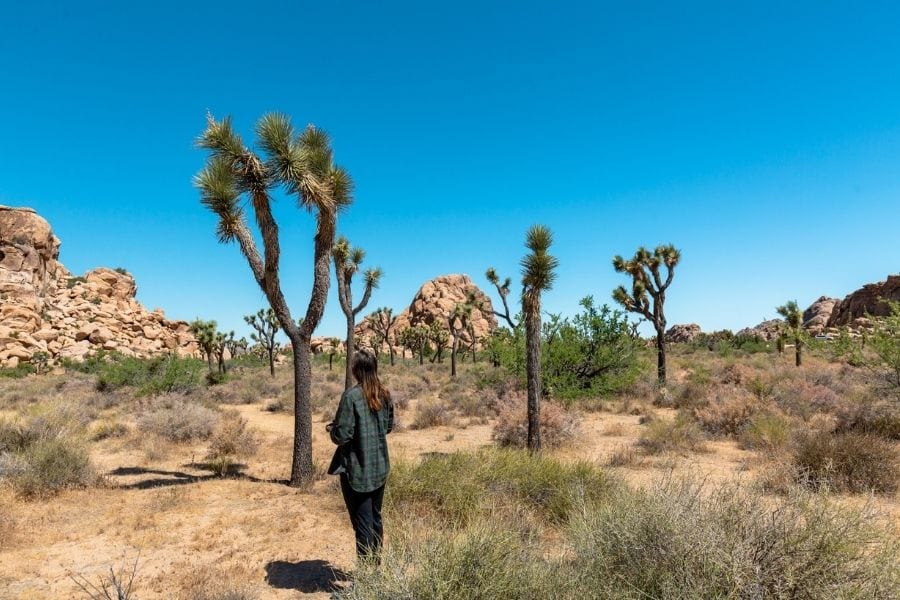
How to Get to Joshua Tree National Park
Joshua Tree National Park is under 3 hours from Los Angeles, San Diego, and Las Vegas, making it an easy weekend escape. Or the perfect add-on to a Southern California road trip!
If you’re visiting Joshua Tree National Park from further away, flying is the best way to get there. There are several airports within a few hours’ drive. I like to use Expedia to check for cheap flights to the closest airport.
Read More: 19 Best National Parks Near Las Vegas
These are the closest airports to Joshua Tree National Park:
- Palm Springs International Airport (PSP): 1 hour
- Ontario International Airport (ONT): 1.5 to 2 hours
- John Wayne Airport (SNA): 2 to 2.5 hours
- Los Angeles International Airport (LAX): 2.5 to 3 hours
- San Diego International Airport (SAN): 2.5 to 3 hours
- Harry Reid International Airport, formerly McCarran Airport (LAS): 3.5 to 4 hours
- Phoenix Sky Harbor International Airport (PHX): 4.5 to 5 hours
I use Expedia to find the best flight prices and compare routes. Once you find your flight, you can book directly through Expedia to save money, but still enter your frequent flyer numbers to get points!
If you need a rental car, I also recommend using Expedia to find the best deals across brands like Avis, Hertz, Enterprise, Budget, and more.
How to Get Around on Your Joshua Tree National Park Day Trip
Unlike other national parks, Joshua Tree does not have a park shuttle or public transportation. To get around the park, you’ll need a vehicle.
The major roads in Joshua Tree are all paved, so for this one day itinerary, renting a sedan is perfectly fine. However, if you want to prioritize exploring some of Joshua Tree’s off-road scenic drives, consider renting a 4WD vehicle instead.
There are three main entrances to Joshua Tree National Park:
- Joshua Tree West Entrance Station, off Highway 62, at the northern edge of the park nearest to the small town of Joshua Tree and the Joshua Tree Visitor Center
- Oasis North Entrance Station, also off Highway 62, at the northern edge of the park, nearest to Twentynine Palms and the Oasis Visitor Center
- Cottonwood South Entrance, at the southern end of the park close to I-10 and home to the Cottonwood Visitor Center
There are only two main roads throughout the park: Park Boulevard and Pinto Basin Road.
Park Boulevard crosses the northern part of the park between the town of Joshua Tree and Twentynine Palms. Pinto Basin Road runs north-south from the Cottonwood Visitor Center to the park’s center, joining Park Boulevard.
You’ll find parking lots at the main attractions and several pullouts along the road throughout the park.
However, during the busy season, parking can be challenging as there is no shuttle, and driving is the only way to explore the park. To find parking, plan to start your day before 9 AM.

Where to Stay Near Joshua Tree National Park
There are no lodges inside Joshua Tree National Park. However, the park is surrounded by several sizeable towns, including Joshua Tree, Yucca Valley, and Twentynine Palms.
This interactive map can help you search all the available hotels and rental properties near Joshua Tree National Park! Simply scroll and click the map below to see what is available!
If you’re looking to stay in a hotel, consider booking at one of these spots close to the park:
- The Castle House Estate in Joshua Tree is a unique experience with historic guard tower bedrooms
- Pioneertown Motel in Pioneertown is a rustic motel with budget-friendly options near the park
- Fairfield Inn & Suites in Twentynine Palms is a reliable Marriott chain close to the park entrance
- Holiday Inn Express in Twentynine Palms is another reliable chain hotel close to the park entrance
There are also several rental properties in the region, some very close to the park entrance. A rental home can be a good alternative if you prefer to have more space, cook your food, or stay at a great place with a unique atmosphere:

Consider booking these rental properties near Joshua Tree:
- The Cherokee House in Joshua Tree is a beautifully decorated, mid-century-style home with outdoor living space
- 28 Palms Ranch in Twentynine Palms has luxury tents with outdoor patios and grills
- AutoCamp in Joshua Tree offers unique stays in luxury Airstream trailers
The only way to stay inside the park is at a campground.
In the slow season from May to September, most of the park’s campgrounds are first come, first served. However, during peak season from October to April, reservations are required for the park’s most popular campgrounds.
These campgrounds are reservable through Recreation.Gov. Plan to book these sites at least 3 to 6 months out. Jumbo Rocks typically fill up six months out.
- Black Rock Campground
- Cottonwood Campground
- Indian Cove Campground
- Jumbo Rocks Campground
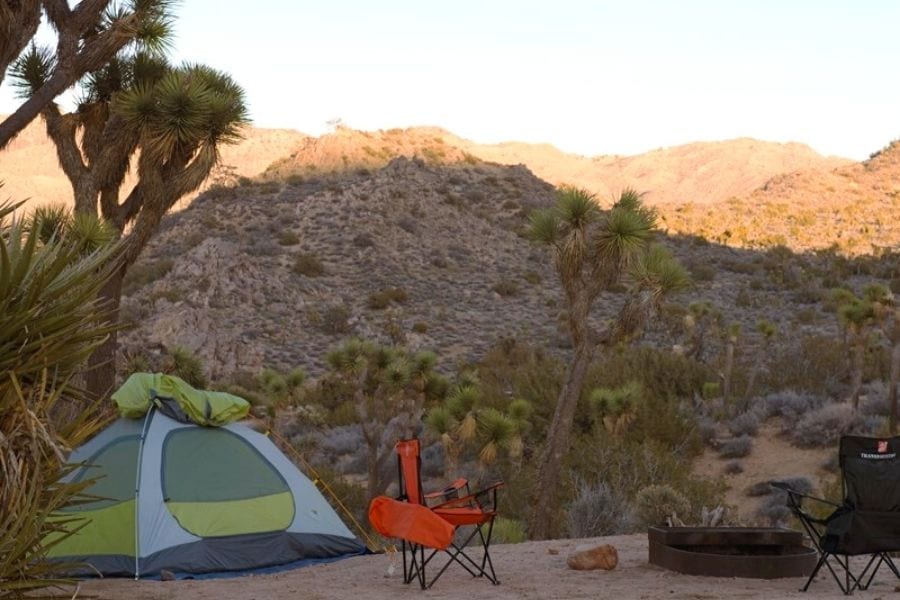
Joshua Tree National Park Entrance Fees
Joshua Tree National Park charges a fee to enter. You can either pay the park entrance fee upon arrival or purchase a national park pass.
If you buy entry upon arrival, you can get a 7-day entrance pass for $30, or an annual Joshua Tree pass for $55.
Are you visiting multiple national parks in the next year? The America the Beautiful National Park Pass gets you into 400+ national park sites, including all 63 national parks, for 12 months!
Get your national park pass ahead of time for only $80.
Best Time to Visit Joshua Tree National Park
The best time to visit Joshua Tree National Park is from October to April when temperatures are milder. Unlike many national parks, Joshua Tree is the least busy in the summer due to extreme heat, where temperatures often exceed 100 degrees.
Here’s a quick overview of what to expect during each season in Joshua Tree:
- Fall: Temperatures begin to cool off after the hot summer starting mid-September. Daytime temperatures start in the 80s but reach the 60s by the end of November. Fall is an excellent time for hiking and rock climbing in Joshua Tree.
- Winter: This season is characterized by cooler, cleared days, much different from the scorching summer. Daytime highs are in the 60s, with overnight temperatures in the 30s. Pack plenty of layers if you’re camping in Joshua Tree in the winter!
- Spring: After a cooler winter, the weather heats up again, and wildflowers bloom. Daytime temperatures are in the low 70s in March but reach the mid-80s by May. Like the fall, this can be a great time to visit for mild weather.
- Summer: Temperates in Joshua Tree from June to early September often pass 100 degrees, making it dangerous to hike during the day. Much of the park is unshaded, so if you visit during the summer, only explore the park at sunrise or sunset to avoid the hottest part of the day.

Important Tips for Your Joshua Tree Day Trip Itinerary
- Pack plenty of water and sunscreen, particularly from spring to fall. Be sure you have at least 2-3 liters of water per person before hiking. Much of the park is exposed, so don’t forget sunscreen and a hat, even in chillier winter months.
- Always check the national park website before visiting. The park regularly publishes closures, including visitor centers, campgrounds, and hiking trails. Check the site before heading into the park to get the latest information. You can find important alerts on the Joshua Tree National Park home page.
- Fill up on gas before entering the park. No gas stations are inside Joshua Tree National Park, so be sure to have a full tank before heading to the park for the day.
- Cell service is limited inside the park. Be sure to download Google Maps offline on your phone before entering the park and pick up a physical map at the entrance station on your way into the park.
- Pack lunch for inside the park. There are no restaurants inside Joshua Tree National Park. Rather than existing the entire park for lunch, plan to pack a picnic lunch and take advantage of one of the park’s many picnic areas.
- Remember to Leave No Trace. Desert environments are very fragile. To preserve the park for future generations, stay away from wildlife, stay on the trail, and pack out trash.
- Don’t miss seeing Joshua Tree at sunrise. The Joshua Trees and Cholla cactuses come alive in the golden morning light. Don’t miss seeing the park in the soft light – it looks so different than it does at midday!
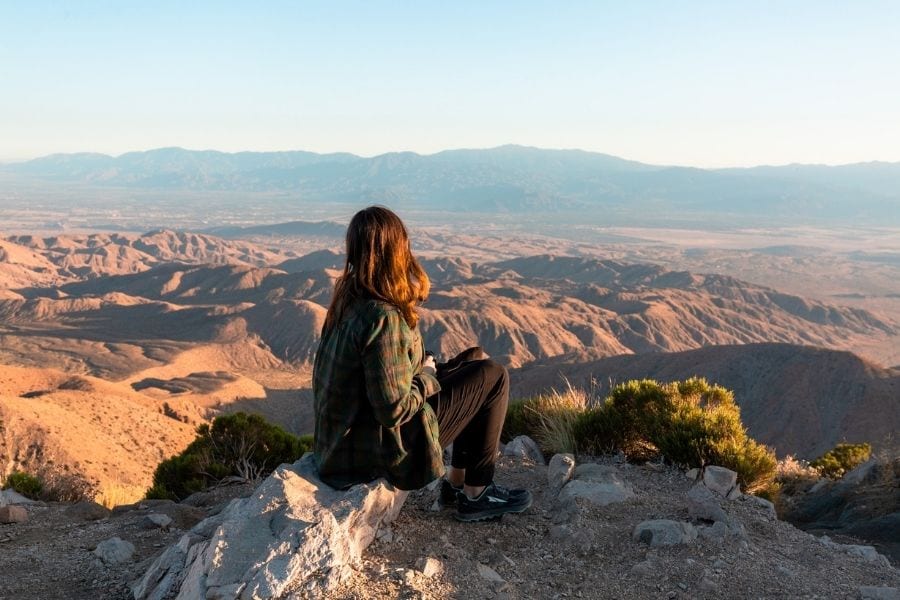
What to Pack for Joshua Tree National Park
- America the Beautiful National Park Pass. This national park pass grants you access to all the US national parks, plus many other federal lands, for only $80 a year. This pass covers you and everyone in your vehicle! To compare, the entry fee to only Joshua Tree National Park is $30.
- Water, tons of water. Desert environments require you to bring double the amount of water you normally would. While some places in the park have water bottle refill stations, I recommend bringing at least 5 gallons of water. We kept a large water jug in the back of the car for emergencies. When hiking in dry, hot environments, you will dehydrate faster. Plan to bring at least 2-3 liters of water with you on every hike, even if you aren’t straying far from the car.
- Sun Protection. Even in cooler winters, the UV index is high, and the park is unshaded. Protect your skin and eyes with a sun hat, sunglasses, and sunscreen (reapply every few hours!).
- 10 Hiking Essentials. Don’t get caught out on the trail without proper supplies. While this itinerary only covers short day hikes, it’s important to be prepared. I’ve had to use my first aid kit on a trail only a mile from my car. Be prepared with a first aid kit and wilderness survival tools. Check out my detailed post on the 10 Hiking Essentials for more information.
- Snacks and Lunch. Joshua Tree National Park has no dining options within the park. Prepare for your long day of exploring by packing lunch and plenty of snacks ahead of time. I like to pack things that don’t need refrigeration, like PB&J, protein bars, trail mix, and beef jerky.
- Extra Layers. The key to comfort in Joshua Tree is layers. Even in the hot Summer months, mornings and evenings in Joshua Tree National Park can be chilly. Always have extra layers, like a fleece pullover or merino wool zip-up. If you are visiting in the Winter, pack a warm hat, gloves, and a down jacket for after sundown.
- Headlamp. Getting those perfect sunrise photos means getting to the park in the dark. Hike safely with a headlamp. You’ll keep your hands free and avoid trampling vegetation and wildlife along the path.
- Offline Maps. I always recommend downloading the area’s map offline in the Google Maps app ahead of time. This will ensure you can navigate the park without cell service (which won’t be available within the park). For offline hiking maps, I recommend AllTrails Pro. But that said, it’s still a good idea to pick up a park map at the entrance station or visitor center.
Looking for more tips on what to pack for your trip? Check out my guides on the best hiking gear, what to pack for a road trip, and essential camping gear for all my favorite gear picks and tips to make packing for your trip a breeze!
One Day Joshua Tree Itinerary
Now that you know everything to plan the perfect Joshua Tree day trip, let’s dive into the itinerary and precisely what to do in Joshua Tree for a day.
If you only have one day in Joshua Tree National Park, follow this itinerary for all the highlights:
- See the sunrise at Cholla Cactus Garden
- Visit Arch Rock and Skull Rock
- Take a hike, like Hidden Valley, Ryan Mountain, or Barker Dam
- See the sunset at Keys View
- Stargazing after dark
Are you planning a national park trip but don’t know where to start? Get my free 28-page national park ebook where I break down everything you need to know to visit all 63 USA national parks.
Download your free ebook here.
Sunrise at Cholla Cactus Garden

If you only have time for one thing in Joshua Tree National Park, this should be it. Cholla Cactus Garden is one of the best Joshua Tree sunrise spots!
As the sun creeps over the horizon, the garden illuminates and glows as these spiny cacti catch the morning sun with distant mountains in the background.
Drive straight through the park to the Cholla Cactus Garden. As you drive through the dark, keep a watch for wildlife. We saw multiple coyotes and a giant owl sitting on the road at 4 am.
It’s a short walk along the ¼ mile dirt trail to photograph the glowing cactus. Plan to arrive at least 45 minutes early to capture the light from dawn through the golden hour.
Read More: 5 Best Joshua Tree Sunrise Spots
Explore the Arch Rock Trail
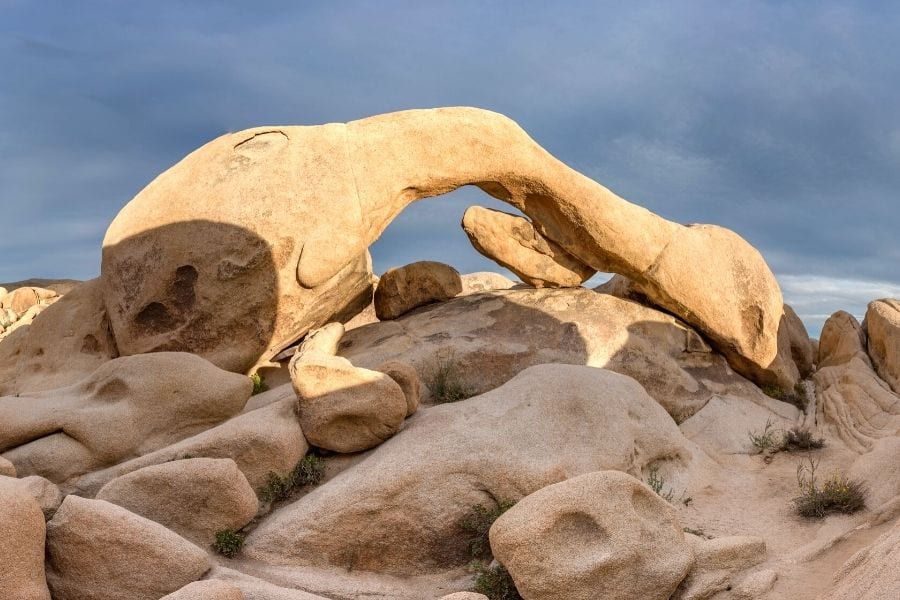
After exploring the Cholla Cactus Garden, head toward Park Boulevard to see Arch Rock. This unique 30-foot arch sits atop a stack of boulders formed from lava pushed up through the fault line.
Unlike many national parks, Joshua Tree allows you to climb along the boulders. Get out, explore, and get your picture on the famous Arch Rock.
To reach Arch Rock, park at the Twin Tanks parking lot. You’ll cross Pinto Basin Road and follow the unmarked trail about 1.4 miles roundtrip to the rock formation.
Since the trail is unmarked, I recommend following the Arch Rock Trail route on AllTrails.
Arch Rock can also be seen on a shorter walk from White Tank Campground. However, parking is unavailable at the campground unless you stay there.
If you have time, consider a quick stop to check out Heart Rock along the trail too!
Photograph Skull Rock
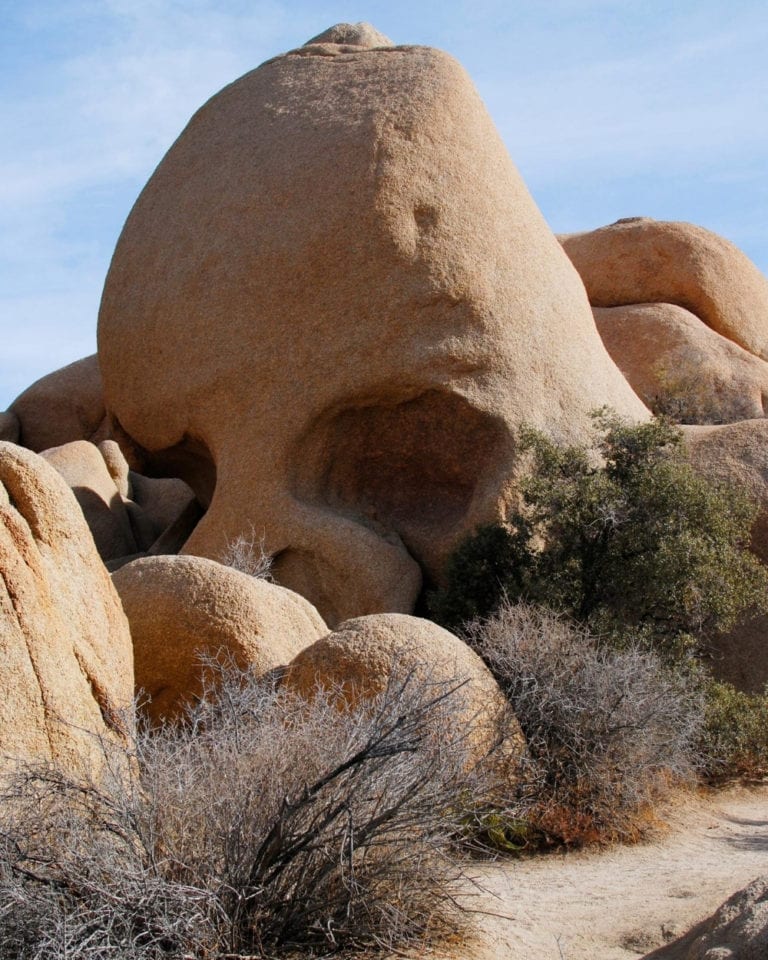
Rejoin Park Boulevard and head to another famous rock formation, Skull Rock.
While you can also hike to see this rock on a trail from Jumbo Rocks Campground, most visitors opt to see the rock from the pull-off along Park Boulevard.
As you might expect, this rock is shaped like a human skull, complete with eye sockets and all! Skull Rock should be quiet in the morning before crowds swarm in the afternoon.
Snap a photo of the “skull” from the path off Park Boulevard.
If you want to explore the area more, take the 1.7-mile loop out to Jumbo Rocks Campground.
Take a Hike in Joshua Tree National Park
There are plenty of excellent hiking trails in Joshua Tree National Park, ranging from easy, family-friendly trails to strenuous summit hikes. If you have plenty of time, you could consider doing several of these best hikes in Joshua Tree.
| Trail | Difficulty | Distance | Elevation | Trailhead |
|---|---|---|---|---|
| Hidden Valley Nature Trail | Easy | 1.0 miles | 100 feet | Hidden Valley Picnic Area |
| Barker Dam Trail | Easy | 1.1 miles | 50 feet | Barker Dam Parking Area |
| Ryan Mountain Trail | Challenging | 3.0 miles | 1,050 feet | Parking Area Between Sheep Pass and Ryan Campground |
Hidden Valley Nature Trail is one of the most popular hikes in the park. This family-friendly loop trail explores a valley historically used by cattle rustlers to hide stolen cattle. Here you can spot many Joshua Trees and Yucca plants. This easy hike is perfect for kids who want to climb and explore the large boulders.
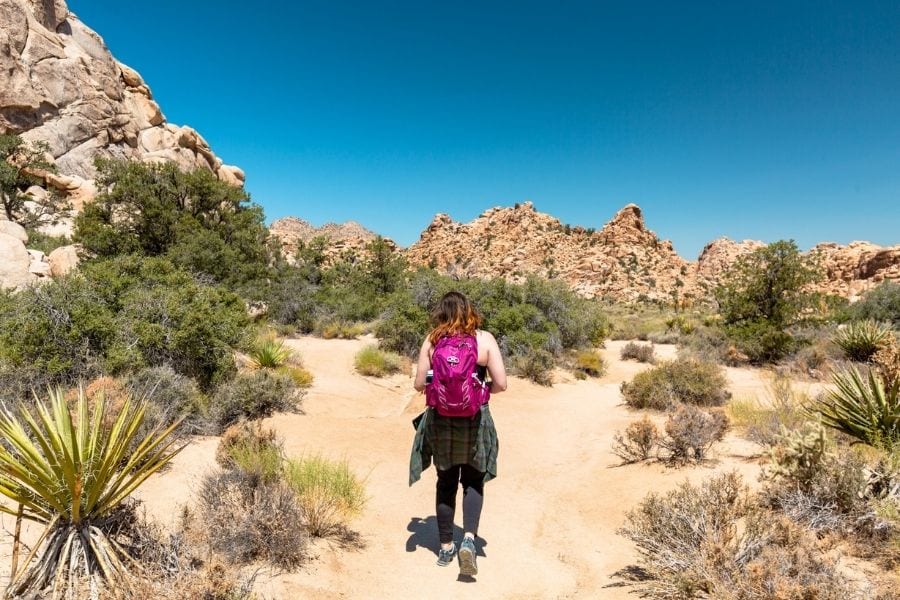
Barker Dam Trail is another easy hiking trail in Joshua Tree that explores a water tank built by early cattle ranchers. The trail is also known for bighorn sheep sightings. While the dam was created to provide year-round water levels to cattle, you’re no longer guaranteed to see water all year at Barker Dam. Your best bet to see the water in the dam is in the late winter to early spring, but this depends on annual rainfall.

Ryan Mountain Trail is one of the more challenging trails in Joshua Tree National Park, taking you to higher elevations. The 3-mile longer hike takes you to the summit of Ryan Mountain, providing sweeping views of the park. This popular trail should be hiked in the morning, particularly in the Summer, before high temperatures hit in the afternoon.

See Sunset at Keys View

End your day trip to Joshua Tree National Park with sunset at Keys View, stopping to capture the Joshua Trees in the late afternoon sun on your way there.
Be sure to arrive at the Keys View parking lot at least 45 minutes before sunset. This scenic spot is popular, and parking will fill up as sunset approaches.
As the sun fades, purples and pinks will illuminate the valley below. As the highest point in the park, Keys View provides excellent views. On a clear day, you can see Palm Springs, the Coachella Valley, the San Andreas Fault, the Salton Sea, and the San Gorgonio Mountains.
After sunset, head back along Keys View Road to take photos of Joshua Trees in the last light of the day. A tripod is crucial for an epic last-light image.
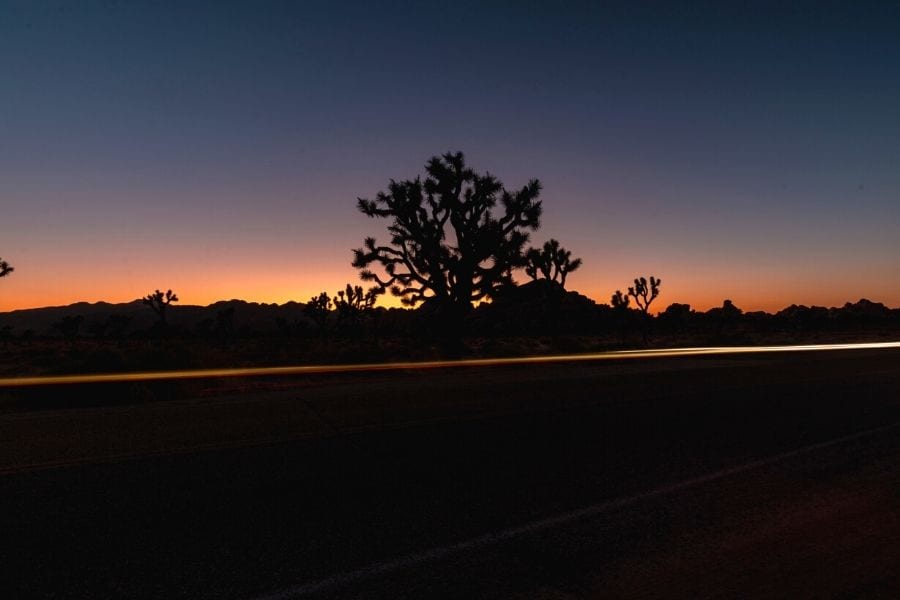
If you’re looking to spend more time in the park, consider sticking around for stargazing. I refer to the Clear Dark Sky charts for guidance on star and Milky Way visibility for night sky viewing.
Nearby Trips to Add to Your Joshua Tree Itinerary
If you have more time in the area, don’t miss these nearby destinations:
- Palm Springs is only one hour away, perfect for a relaxing retreat filled with spas and luxury houses.
- Joshua Tree’s proximity to big cities like Los Angeles, San Diego, and Las Vegas make it the perfect road trip destination. Explore more of Southern California before venturing up the coast on the Pacific Coast Highway!
- Add more California national parks to your road trip! Nearby California parks include the Channel Islands and Death Valley National Park. Plus, Grand Canyon National Park is nearby too!
Frequently Asked Questions About a Day Trip to Joshua Tree
Can you do Joshua Tree in a day?
Yes! Joshua Tree is one of the best national parks to see in only a day. In one day, you can see the highlights of Joshua Tree, including Cholla Cactus Garden, Ryan Mountain, and sunset at Keys View.
How much time do you need in Joshua Tree?
You only need one day to see the highlights of Joshua Tree National Park. If you want to explore the park’s backcountry or off-road drives, plan to spend at least 2 to 3 days in Joshua Tree.
Can you do Joshua Tree in a few hours?
If you’re only interested in seeing the main attractions and won’t be doing any hiking, you can easily see Joshua Tree in just a few hours. You can see the Cholla Cactus Garden, Arch Rock, Skull Rock, and Keys View in only a few hours.
Is Joshua Tree worth the trip? Is Joshua Tree worth the hype?
Yes! Joshua Tree is definitely worth the trip. From unique teddy bear cholla cacti to Joshua trees and boulders, Joshua Tree national park is incredibly diverse. This park has something that everyone will enjoy. Plus, it’s close to major cities like Los Angeles, making it an easy day trip.
Is Joshua Tree worth driving through?
Joshua tree is a large national park with two main roads through the park. Joshua Tree is worth driving through if you only have a half day or one day. You can see plenty from the scenic drive, including boulders, cacti, and the famous Joshua Trees.
Is Joshua Tree a day trip from Palm Springs?
Joshua Tree is only one hour away from Palm Springs, making it an easy day trip and worth the trip. You can start your day at the northwest entrance of Joshua Tree, work your way through the park, and return to Palm Springs through the southern park entrance.
Final Thoughts on the Joshua Tree One Day Itinerary
Joshua Tree National Park is the perfect park to explore in just one day – just enough time to see the highlights!
If you only have time for one day in Joshua Tree National Park, this is what to see in Joshua Tree in one day.
- Sunrise at Cholla Cactus Garden
- Exploring Arch Rock and Skull Rock
- Take a hike, like Hidden Valley, Barker Dam, or Ryan Mountain
- Sunset at Keys View
- Stargazing after dark
Are you looking for more ideas for your trip to Joshua Tree? Don’t miss this post on the best Joshua Tree sunrise spots!
Are you planning a national park trip but don’t know where to start? Get my free 28-page national park ebook where I break down everything you need to know to visit all 63 USA national parks.
Download your free ebook here.
Don’t Forget to Save This Post on Pinterest
